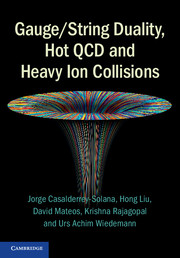Book contents
- Frontmatter
- Contents
- 1 Opening remarks
- 2 A heavy ion phenomenology primer
- 3 Results from lattice QCD at nonzero temperature
- 4 Introducing the gauge/string duality
- 5 A duality toolbox
- 6 Bulk properties of strongly coupled plasma
- 7 From hydrodynamics to far-from-equilibrium dynamics
- 8 Probing strongly coupled plasma
- 9 Quarkonium mesons in strongly coupled plasma
- 10 Concluding remarks and outlook
- Appendix A Green–Kubo formula for transport coefficients
- Appendix B Hawking temperature of a general black brane metric
- Appendix C Holographic renormalization, one-point functions, and a two-point function
- Appendix D Computation of the holographic stress tensor
- References
- Index
1 - Opening remarks
Published online by Cambridge University Press: 05 July 2014
- Frontmatter
- Contents
- 1 Opening remarks
- 2 A heavy ion phenomenology primer
- 3 Results from lattice QCD at nonzero temperature
- 4 Introducing the gauge/string duality
- 5 A duality toolbox
- 6 Bulk properties of strongly coupled plasma
- 7 From hydrodynamics to far-from-equilibrium dynamics
- 8 Probing strongly coupled plasma
- 9 Quarkonium mesons in strongly coupled plasma
- 10 Concluding remarks and outlook
- Appendix A Green–Kubo formula for transport coefficients
- Appendix B Hawking temperature of a general black brane metric
- Appendix C Holographic renormalization, one-point functions, and a two-point function
- Appendix D Computation of the holographic stress tensor
- References
- Index
Summary
The discovery in the late 1990s of the AdS/CFT correspondence, as well as its subsequent generalizations now referred to as the gauge/string duality, have provided a novel approach for studying the strong coupling limit of a large class of non-Abelian quantum field theories. In recent years, there has been a surge of interest in exploiting this approach to study properties of the plasma phase of such theories at nonzero temperature, including the transport properties of the plasma and the propagation and relaxation of plasma perturbations. Besides the generic theoretical motivation of such studies, many of the recent developments have been inspired by the phenomenology of ultra-relativistic heavy ion collisions. Inspiration has acted in the other direction too, as properties of non-Abelian plasmas that were determined via the gauge/string duality have helped to identify new avenues in heavy ion phenomenology. There are many reasons for this at-first-glance surprising interplay among string theory, finite-temperature field theory, and heavy ion phenomenology, as we shall see throughout this book. Here, we anticipate only that the analysis of data from the Relativistic Heavy Ion Collider (RHIC) had emphasized the importance, indeed the necessity, of developing strong coupling techniques for heavy ion phenomenology. Now, this case is further strengthened by data from the CERN Large Hadron Collider (LHC). For instance, in the calculation of an experimentally accessible transport property, the dimensionless ratio of the shear viscosity to the entropy density, weak and strong coupling results turn out to differ not only quantitatively but parametrically, and data favor the strong coupling result.
- Type
- Chapter
- Information
- Publisher: Cambridge University PressPrint publication year: 2014



